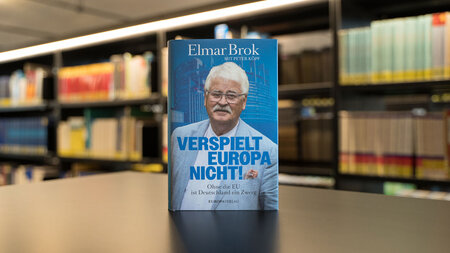Premiere at Hannover Messe: Fully 3D-Printed Electric Motors
Chemnitz University electrical engineers are the first in the world to print electric motors using iron, copper and ceramics
 open gallery
open gallery -

Johannes Rudolph observes the multimedia 3D-printing of an electrical machine in the lab. This is the first time copper, ceramics and iron have been used simultaneously in the printing process. On the left are the rotors and the stator is on the right. Photo: Jacob Müller -

These stators of a 3-phase reluctance machine were manufactured using multimedia 3D-printing. Photo: Jacob Müller -

Fabian Lorenz examines the stator of a printed electrical machine compared to three previous steps in the development of 3D-printing at the Professorship of Electrical Energy Conversion Systems and Drives. From left: copper coil, ceramic-insulated coil, inductor with separately printed iron core and electrical machine. Photo: Jacob Müller
Using metallic and ceramic pastes, extruded layer by layer into a predetermined form and then sintered together, researchers from the Chemnitz University of Technology Professorship of Electrical Energy Conversion Systems and Drives were able to 3D-print an entire electric motor. “We will present this innovation, the first of its kind in the world, at the ‘Hannover Messe 2018’ trade fair,” reports Prof. Dr. Ralf Werner, head of the Professorship. Last year, two members of his academic staff, Johannes Rudolph and Fabian Lorenz, presented a 3D-printed coil capable of withstanding temperatures over 300°C. Since that time, they have successfully printed all important components of an electrical machine. This includes copper electrical conductors, which create magnetic fields in combination with iron or iron alloys and ceramic electrical insulation, which insulates the conductors from each other and from the iron components, referred to as the magnetic circuit.
“Our goal over the last two and a half years was to dramatically increase the temperature that electrical machines are capable of withstanding,” reports Werner. The researchers in Chemnitz have achieved this by replacing conventional polymer-based insulation materials with specialized ceramics, which have a much higher degree of temperature resistance. “The maximum permissible winding temperature of 220°C associated with conventional insulation systems can then be exceeded by a significant amount. The operating temperature of electric machines is therefore only limited by the ferromagnetic properties of the iron components, which can only be maintained up to 700°C,” adds Rudolph.
Along with the ability to withstand higher temperatures, the ceramic insulation material also possesses a higher degree of thermal conductivity. Thereby, heat loss generated in the conductors can be more quickly dissipated. This advantage enabled the scientists to achieve another important goal of their work: increasing the output density of electrical machines. “Despite the process-related decrease in the conductivity of the copper used, in specific application scenarios, it is possible to increase the degree of efficiency by significantly reducing the winding temperature,” continues Lorenz.
The printing process that the Chemnitz-based researchers intend to develop for introduction into the market is based on extruding highly viscous pastes layer by layer. These pastes consist of particles of the desired materials, such as iron, copper or ceramics, and specially-adapted bonding agents. In order to achieve the necessary degree of precision when dispensing the pastes, the researchers work closely with the ViscoTec Pumpen- u. Dosiertechnik GmbH company located in Töging am Inn.
“The motor that was printed in the Chemnitz University Laboratory represents a breakthrough and is at the same time the proof of principle – it demonstrates the feasibility – of our technology,” assures Rudolph, who was heavily involved in the development of the manufacturing technique and is preparing to launch a university spin-off company with Lorenz. The researchers will present their latest research developments from April 23 through 27, 2018 at the Hannover Messe trade fair. They will be located at the “Forschung für die Zukunft” stand that they will share with other co-exhibitors in Hall 2, Stand A38. There, Rudolph and Lorenz hope to generate even more interest in their new multimedia 3D-printing process.
“Multimedia 3D-Printing” Homepage: https://www.tu-chemnitz.de/etit/ema/AMMM/index.php (in German)
More information is available from Johannes Rudolph, Tel.: +49 371 531-38938, johannes.rudolph@etit.tu-chemnitz.de, and Fabian Lorenz, Tel.: +49 371 531-32482, fabian.lorenz@etit.tu-chemnitz.de
(Translation: Sarah Wilson)
Matthias Fejes
17.04.2018





